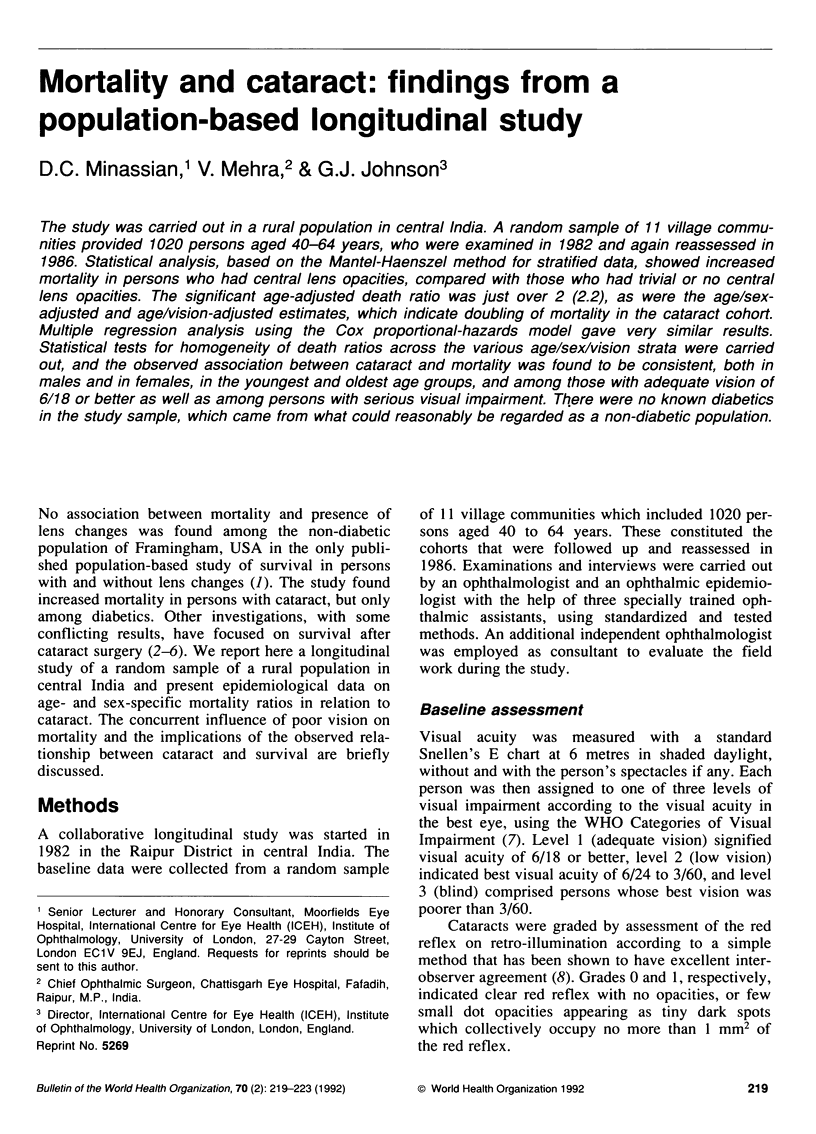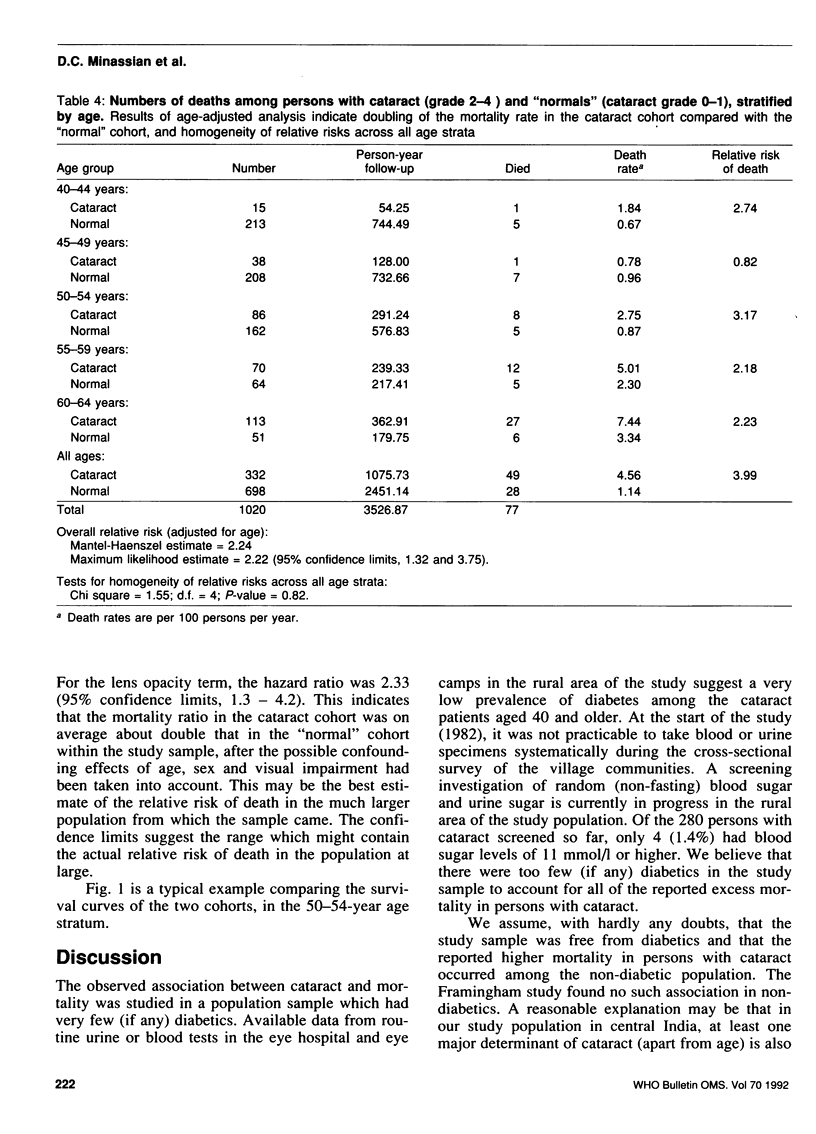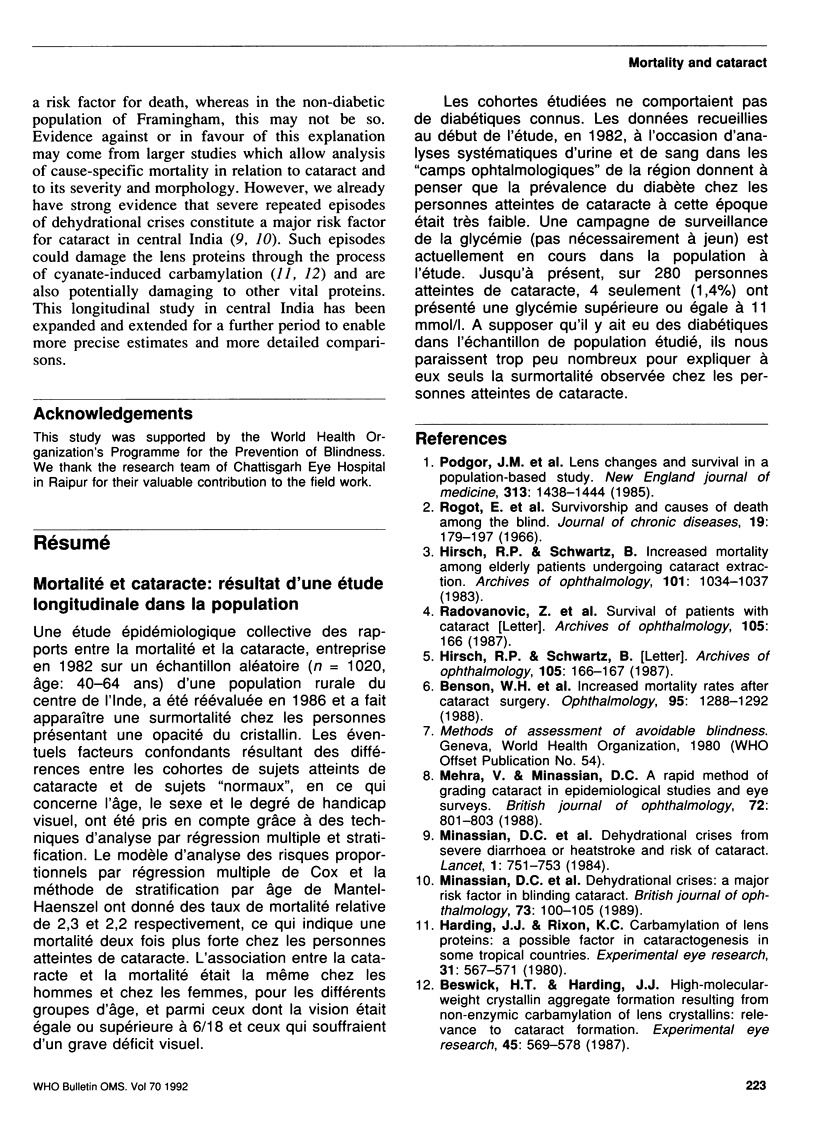Abstract
The study was carried out in a rural population in central India. A random sample of 11 village communities provided 1020 persons aged 40-64 years, who were examined in 1982 and again reassessed in 1986. Statistical analysis, based on the Mantel-Haenszel method for stratified data, showed increased mortality in persons who had central lens opacities, compared with those who had trivial or no central lens opacities. The significant age-adjusted death ratio was just over 2 (2.2), as were the age/sex-adjusted and age/vision-adjusted estimates, which indicate doubling of mortality in the cataract cohort. Multiple regression analysis using the Cox proportional-hazards model gave very similar results. Statistical tests for homogeneity of death ratios across the various age/sex/vision strata were carried out, and the observed association between cataract and mortality was found to be consistent, both in males and in females, in the youngest and oldest age groups, and among those with adequate vision of 6/18 or better as well as among persons with serious visual impairment. There were no known diabetics in the study sample, which came from what could reasonably be regarded as a non-diabetic population.
Full text
PDF




Selected References
These references are in PubMed. This may not be the complete list of references from this article.
- Benson W. H., Farber M. E., Caplan R. J. Increased mortality rates after cataract surgery. A statistical analysis. Ophthalmology. 1988 Sep;95(9):1288–1292. doi: 10.1016/s0161-6420(88)33019-8. [DOI] [PubMed] [Google Scholar]
- Beswick H. T., Harding J. J. High-molecular-weight crystallin aggregate formation resulting from non-enzymic carbamylation of lens crystallins: relevance to cataract formation. Exp Eye Res. 1987 Oct;45(4):569–578. doi: 10.1016/s0014-4835(87)80067-2. [DOI] [PubMed] [Google Scholar]
- Harding J. J., Rixon K. C. Carbamylation of lens proteins: a possible factor in cataractogenesis in some tropical countries. Exp Eye Res. 1980 Nov;31(5):567–571. doi: 10.1016/s0014-4835(80)80015-7. [DOI] [PubMed] [Google Scholar]
- Hirsch R. P., Schwartz B. Increased mortality among elderly patients undergoing cataract extraction. Arch Ophthalmol. 1983 Jul;101(7):1034–1037. doi: 10.1001/archopht.1983.01040020036004. [DOI] [PubMed] [Google Scholar]
- Mehra V., Minassian D. C. A rapid method of grading cataract in epidemiological studies and eye surveys. Br J Ophthalmol. 1988 Nov;72(11):801–803. doi: 10.1136/bjo.72.11.801. [DOI] [PMC free article] [PubMed] [Google Scholar]
- Minassian D. C., Mehra V., Jones B. R. Dehydrational crises from severe diarrhoea or heatstroke and risk of cataract. Lancet. 1984 Apr 7;1(8380):751–753. doi: 10.1016/s0140-6736(84)91274-1. [DOI] [PubMed] [Google Scholar]
- Minassian D. C., Mehra V., Verrey J. D. Dehydrational crises: a major risk factor in blinding cataract. Br J Ophthalmol. 1989 Feb;73(2):100–105. doi: 10.1136/bjo.73.2.100. [DOI] [PMC free article] [PubMed] [Google Scholar]
- Podgor M. J., Cassel G. H., Kannel W. B. Lens changes and survival in a population-based study. N Engl J Med. 1985 Dec 5;313(23):1438–1444. doi: 10.1056/NEJM198512053132303. [DOI] [PubMed] [Google Scholar]
- Radovanović Z., Cvetković D., Marinković J., Velimirović A., Hentova-Sencanić P. Survival of patients with cataract. Arch Ophthalmol. 1987 Feb;105(2):166–167. doi: 10.1001/archopht.1987.01060020020003. [DOI] [PubMed] [Google Scholar]
- Rogot E., Goldberg I. D., Goldstein H. Survivorship and causes of death among the blind. J Chronic Dis. 1966 Feb;19(2):179–197. doi: 10.1016/0021-9681(66)90048-8. [DOI] [PubMed] [Google Scholar]


